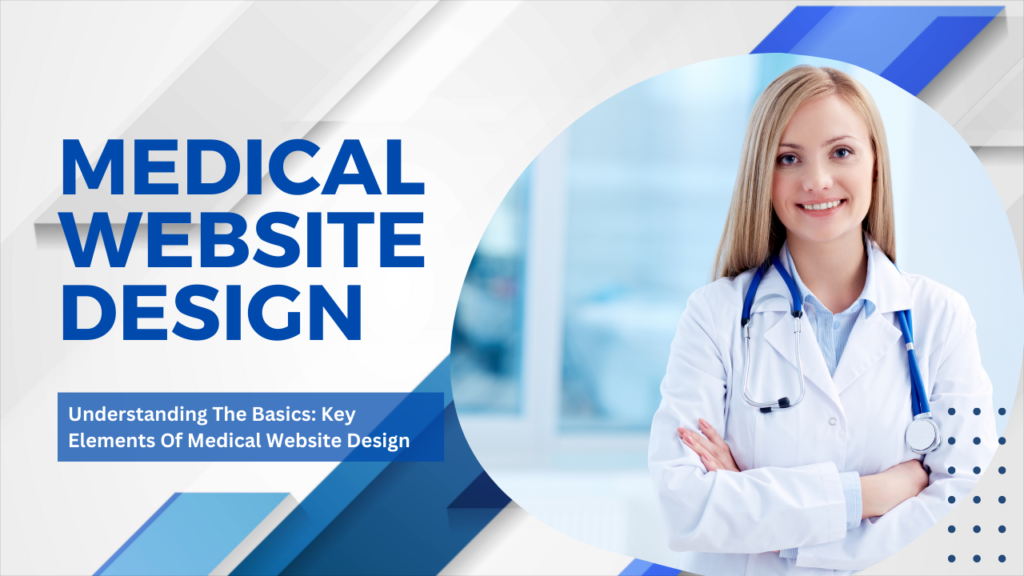In today’s digital age, medical practitioners are increasingly relying on their websites to establish their online presence and connect with patients. A well-designed website can provide valuable information about services offered, provider credentials, and patient resources.
However, creating an effective medical website requires a deep understanding of the key elements that make up a successful design.
Medical website design is not just about aesthetics; it encompasses usability, content creation, call-to-action strategies, accessibility, navigation, branding, and loading time optimization. Each of these elements plays a crucial role in creating an engaging user experience that fosters trust and encourages interaction between patients and healthcare providers.
In this article, we will explore the basics of Medical Website design and how each element contributes to the overall success of your online presence.
Usability: Creating a User-Friendly Experience
The creation of a user-friendly experience is a crucial component in the development of medical websites, as it ensures ease of navigation and accessibility for users with varying levels of technical proficiency.
Understanding user behavior is essential to create an engaging website that meets their needs. User testing can help identify potential issues and improve user satisfaction. A website’s usability should be intuitive, logical, and consistent across all pages. It should also be accessible across different devices and platforms.
A well-designed medical website can enhance the patient’s experience by providing clear information about health conditions and treatment options. The next step in creating an effective medical website is visual appeal: making a great first impression without compromising usability and accessibility.
Visual Appeal: Making a Great First Impression
Visual appeal is a crucial aspect of medical website design as it creates the first impression for visitors. Using high-quality images and graphics can enhance the overall look and feel of the website, making it more visually attractive to users.
Choosing a cohesive color scheme that aligns with the brand identity can also help create an appealing aesthetic for the site, improving user engagement and satisfaction.
Using High-Quality Images and Graphics
Incorporating high-quality images and graphics into medical website design can enhance the user experience and effectively convey important information to visitors. Using stock photos that accurately represent the content of the website can help users understand the message being conveyed, while also adding visual appeal.
Additionally, including alt tags for all images is essential for accessibility, as it allows visually impaired users to understand what is being displayed on the page through screen readers.
By prioritizing high-quality visuals, medical websites can create an engaging experience that encourages visitors to stay on the site longer and return in the future. In order to maintain a cohesive look and feel throughout the site, choosing a color scheme that complements these visuals is also crucial.
Choosing a Cohesive Color Scheme
Selecting a color scheme that harmonizes with high-quality images and graphics can contribute to creating a cohesive user experience on medical websites. Color psychology plays an important role in website design, as it can influence users’ emotions and behaviors.
For example, blue is often associated with trust and reliability, making it a common choice for healthcare websites. Additionally, using color contrast can make key information stand out and improve readability. It’s important to consider accessibility when choosing colors, ensuring that individuals with visual impairments or color blindness can still use the website effectively.
Ultimately, by carefully choosing a cohesive color scheme, medical websites can not only improve aesthetics but also enhance usability and user satisfaction. This leads us into the next section about content creation: providing valuable information.
Content Creation: Providing Valuable Information
One crucial aspect of medical website design is the creation of informative and valuable content that caters to the needs of its target audience. Creating engaging content is essential for keeping visitors on the site longer, increasing retention rates, and promoting repeat visits.
To maximize SEO potential, it’s important to create high-quality, informative content that utilizes relevant keywords and phrases that your target audience would use to find your site. When creating content, consider using a mix of formats such as videos, infographics, blogs, and podcasts to cater to different learning styles.
Additionally, make sure your content reflects the latest medical research and developments in your field to showcase your expertise and authority. By providing valuable information to patients in an engaging way through diverse media formats while leveraging SEO optimization techniques, you can enhance user experience on your site while also building credibility within the industry.
This will ultimately help encourage patient interaction through effective call-to-action strategies which we’ll discuss in our next section about how best to engage with patients online without being pushy or overly aggressive.
Call-to-Action: Encouraging Patient Interaction
The call-to-action is an essential element of medical website design as it encourages patient interaction and engagement. One such interaction is the promotion of appointment scheduling, which allows patients to book appointments online quickly.
Another form of interaction is encouraging patient reviews and feedback, which helps build trust with potential patients and provides valuable insights for healthcare providers to improve their services. Incorporating these elements into a medical website can enhance the user experience and increase patient conversion rates.
Promoting Appointment Scheduling
To enhance patient engagement and convenience, facilitating appointment scheduling on medical websites is an essential feature. Online scheduling allows patients to book appointments at their own convenience, eliminating the need for phone calls or in-person visits.
Additionally, appointment reminders can be sent through email or text message, reducing the likelihood of missed appointments and improving patient satisfaction. By promoting appointment scheduling on medical websites, healthcare providers can improve patient access to care while also streamlining their administrative processes.
In the next section, we will discuss how encouraging patient reviews and feedback can further improve the effectiveness of medical website design.
Encouraging Patient Reviews and Feedback
Encouraging patient reviews and feedback can provide valuable insights for healthcare providers to improve their services and enhance patient satisfaction. Patient satisfaction is a critical metric in the healthcare industry, and online reputation management has become an essential strategy for medical practices to attract new patients.
By providing a platform for patients to share their experiences, healthcare providers can identify areas of improvement, address negative feedback promptly, and highlight positive reviews on their website. It also provides an opportunity to engage with patients actively and build a sense of community around the practice.
Moreover, patient reviews play a crucial role in search engine rankings, as Google and other search engines prioritize websites with high ratings and positive feedback. As such, it’s crucial to encourage patients to leave reviews on different platforms like Google My Business or Yelp while ensuring compliance with HIPAA regulations.
In the next section about accessibility: making the website inclusive… …by incorporating features such as alt text for images, easy-to-read fonts and color schemes, closed captioning for videos, and keyboard navigation options for individuals with disabilities.
Accessibility: Making the Website Inclusive
Implementing accessibility features is essential to ensure that medical websites are inclusive and cater to the needs of all users, regardless of their physical abilities or disabilities. Inclusive design refers to creating products and services that can be used by everyone, regardless of their age, gender, culture, or ability.
Medical websites need to adhere to accessibility standards set forth by organizations such as the World Wide Web Consortium (W3C) for web content accessibility guidelines (WCAG). This includes providing alternative text descriptions for images, captions for videos, and audio descriptions for those who are visually impaired or hard of hearing.
Additionally, ensuring that the website can be navigated easily using a keyboard instead of a mouse is essential for individuals with mobility impairments. Implementing these features not only makes the website more inclusive but also enhances its usability for all users.
Ensuring that medical websites are accessible creates an environment where all patients can access necessary information without any barriers or limitations.
In terms of security: protecting patient information is critical in maintaining trust between healthcare providers and patients.
Security: Protecting Patient Information
When it comes to medical website design, security should be a top priority. Two key elements that can enhance the security of a medical website are using secure web hosting and encrypting sensitive information.
Secure web hosting ensures that the website is protected from attacks, while encryption helps to safeguard any sensitive data that may be transmitted through the site. By implementing these measures, medical websites can provide patients with peace of mind knowing that their information is safe and secure.
Using Secure Web Hosting
Utilizing secure web hosting is crucial for medical website design in order to ensure the protection of sensitive patient information. Secure web hosting providers offer various levels of security features, such as SSL certificates, which encrypt all data that is transmitted between the user’s browser and the website server.
This encryption method ensures that any intercepted data remains unreadable and inaccessible to unauthorized individuals. An SSL certificate also provides authentication, confirming that the website being accessed is legitimate and not a fake created by hackers attempting to steal sensitive information.
Without proper security measures in place, medical websites risk exposing their patients’ personal and confidential information, which can lead to legal liabilities and loss of trust from their clients. Therefore, it is essential for medical websites to use secure web hosting with SSL certificates to protect patient privacy and maintain a professional reputation online.
As we move forward into our discussion on encrypting sensitive information, it’s important to note that utilizing secure web hosting with an SSL certificate is just one step towards ensuring the highest level of security possible for medical websites.
Encrypting Sensitive Information
After ensuring secure web hosting for your medical website, the next crucial step in protecting patient information is data encryption. This is accomplished by converting sensitive data into a code that can only be deciphered with a specific key or password.
Encryption provides an additional layer of privacy protection against unauthorized access to personal health information. To further emphasize the importance of encrypting sensitive information, here are four reasons why it should not be overlooked:
- Protects data from cybercriminals and hackers
- Reduces the risk of identity theft and fraud
- Ensures compliance with healthcare regulations such as HIPAA
- Builds trust with patients who expect their private health information to remain confidential
As a healthcare provider, it is your responsibility to take every measure possible to safeguard patient information on your website through data encryption. By doing so, you demonstrate a commitment to maintaining the highest level of privacy protection for those in your care.
Moving forward, let’s explore how effective navigation helps patients find what they need on your medical website without feeling overwhelmed or lost in search engines and directories.
Navigation: Helping Patients Find What They Need
Efficient and effective navigation on medical websites is crucial in enabling patients to easily find the information they need. Search bar optimization and menu organization are two key elements that should be emphasized when designing a medical website’s navigation system.
A well-optimized search bar can help patients quickly find what they need, without having to navigate through multiple pages or menus. Additionally, organizing the menu in a clear and logical manner can also aid in the patient’s ease of use.
Medical websites should prioritize creating an intuitive user experience with their navigation design, as it ultimately improves patient satisfaction and makes accessing important information more seamless.
A professional and easy-to-use website enhances the perception of the healthcare provider’s brand and credibility, which is why branding is another essential aspect to consider when designing a medical website.
Branding: Creating a Professional Image
Developing a professional brand image is an essential aspect of creating a lasting impression on patients visiting healthcare websites, as it helps to establish trust and credibility. Creating a memorable brand identity is crucial in ensuring that the website stands out from its competitors and attracts potential patients.
A well-designed logo, color scheme, and typography are key elements in establishing a strong online presence. Consistency in branding across all platforms, including social media pages, newsletters, and email marketing campaigns, can also help to reinforce the brand’s identity.
Providing patients with valuable content that aligns with the brand’s messaging can further enhance the website’s credibility. By prioritizing branding efforts when designing medical websites, healthcare providers can create a positive first impression while building trust with their audience. Next up: loading time – optimizing website performance.
Loading Time: Optimizing Website Performance
Optimizing website performance is crucial in creating a positive user experience for patients visiting healthcare websites. One of the key elements of website design that directly impacts user experience is load time. In today’s fast-paced world, users expect websites to load quickly and efficiently.
Slow loading times can cause frustration and lead to high bounce rates, which negatively affect a website’s search engine rankings. Therefore, optimizing load time and improving website speed are essential components of medical website design. A study by Google found that 53% of mobile site visits were abandoned if pages took longer than three seconds to load.
To ensure optimized load times, designers need to consider factors such as image compression, server response time, and minification of code. The table below summarizes these factors along with their impact on website performance.
| Factor | Impact |
|---|---|
| Image Compression | Reduces file size without sacrificing quality |
| Server Response Time | Determines how quickly the server responds after receiving a request |
| Minification of Code | Removes unnecessary characters from code to reduce the file size |
Continuously testing and optimizing the website is the next step toward ensuring an optimal user experience for patients visiting healthcare websites.
Testing and Optimization: Continuously Improving the Website
By continuously testing and optimizing healthcare websites, designers can ensure that patients have a seamless and enjoyable experience. A/B testing is an effective way to identify which design elements work best for users, allowing designers to make data-driven decisions when making changes to the website.
This process involves creating two versions of a web page with slight variations in design or content, then randomly assigning users to one of the pages to see which version performs better. User engagement is also crucial in ensuring that patients stay on the website and find the information they need.
Designers should prioritize easy navigation, clear calls-to-action, and relevant content to keep users engaged and interested in exploring more of the website. By continually testing and optimizing their medical websites, healthcare providers can provide a user-friendly platform that ultimately benefits both patients and healthcare professionals alike.
Please contact us if you need a Medical Website Design.


















